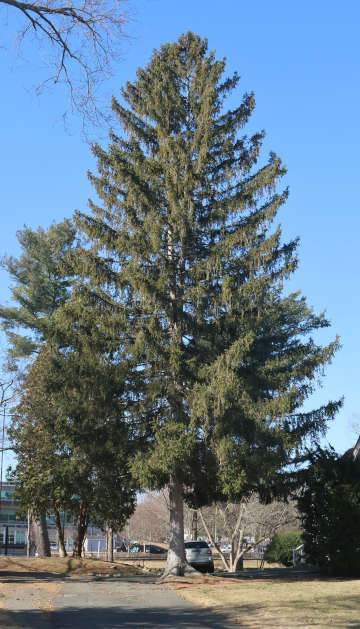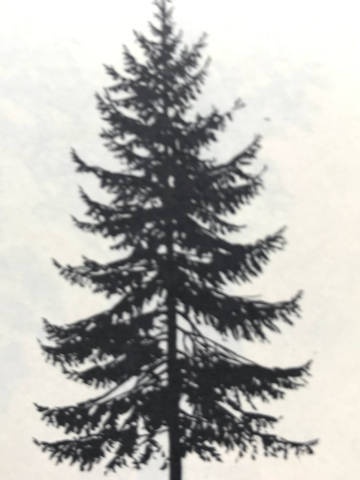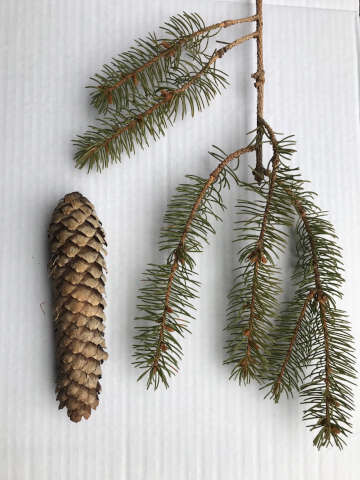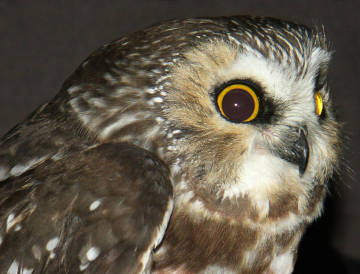Nature Notes

PHOTO COURTESY OF GARRY KESSLER
A mature Norway spruce tree
March 16, 2025
NATURE NOTES
By Annie Reid
Westborough Community Land Trust
Notice Norway spruce in March
How can we appreciate nature in March, as it alternates between “lion” and “lamb” days in a brown and leafless natural world? Try noticing local evergreen conifers. Their green stands out in the bare landscape. Norway spruce trees are especially easy to recognize. Look for them in yards, neighborhoods, and woods.
Norway spruce (Picea abies) is one of the evergreen trees that you’re most likely to see in our region. Two others are eastern white pine (Pinus strobus,) and eastern hemlock (Tsuga canadensis,).
A Norway spruce is distinctive and even obvious. These trees are tall, typically growing 50-80 feet high (but up to 100+ ft) and spreading 40 feet wide, in a pyramid shape. Their tops can rise above a forested horizon (as eastern white pines also do).

Norway spruce silhouette The Norway spruce silhouette shows drooping but upcurved branches.
The Norway spruce silhouette features drooping but upcurved branches with long 6-inch branchlets hanging down. You might imagine that a mature tree seems draped with skirts. Norway spruce’s dark green, 1-inch needles feel square to your fingertips and are attached individually to branches, like other spruces. (In contrast, pines have needles attached in groups, as in eastern white pine, with five long needles bundled together.) The dense branching pattern makes Norway spruce graceful-looking and useful as a privacy screen, windbreak, snowbreak, and sound barrier. It’s also cover for birds and mammals such as deer and red squirrels.
As its name suggests, Norway spruce is not native. Rather, it has become naturalized, meaning that it has become established in our environment, growing and living successfully without causing harm to the local ecology. (What’s ecology? You can think of ecology as all the relationships among organisms and between organisms and the physical environment.) Basically, Norway spruce fits in without making trouble. Massachusetts does not list it as an invasive species.
Norway spruce is native to Eurasia. It spread to Scandinavia around 500 BC. Later it was introduced to the British Isles around 1500 AD. It arrived here, not specifically from Norway, but via colonists who brought it with them. People have planted it widely in North America since then, in growing zones 2-7. (We’re in zone 6.) If you find a Norway spruce in the woods, it’s a clue that people once used the area, perhaps for farming. For example, along the all-persons trail at Westborough’s Gilmore Pond, a large, old Norway spruce grows next to the pond, which was dug as farm pond in the 1930s.

Norway spruce 5-inch pinecone and branch with 6-inch branchlets
If you’re out walking and notice long, 5-inch pine cones underfoot, look up – a Norway spruce is probably nearby (or perhaps an eastern white pine). Norway spruce produces two types of cones: pollen-producing male cones on the tree’s lower parts, and seed-producing female cones on the tree’s upper parts. These trees are wind-pollinated in spring (May-June). The female cones release seeds in late fall into winter.
Norway spruce’s root system helps it adapt to different soils and conditions, even harsh ones. The tree has no taproot. Instead, it has a shallow, fibrous root system with networks of small roots. The roots can spread out 2-3 times the height of the tree and grow 1-5 feet deep. They anchor the tree and quickly absorb water and nutrients, making it drought-resistant. The tree does not do well in wet soil or swampy conditions. It is not fire-resistant.
Norway spruce grows quickly, up to 2 feet per year. Young trees are shade-tolerant. Old trees become scraggly-looking.
People have found many uses for Norway spruce, including for timber, wood for musical instruments, and re-forestation projects. It tolerates cold, pollution, and is deer-resistant.
Norway spruce is popular as a Christmas tree. Last year’s Rockerfeller Center Christmas Tree (2024) in New York City was a Norway spruce from Stockbridge, MA. Norway spruces from various states were used 80 percent of the time since this tradition began in 1931. (The other 20 percent were balsam fir or northern white spruce). What about Boston’s Christmas tree? It is gifted by Nova Scotia every year since 1971 as thanks for Boston’s help after the Halifax Explosion (1917). And no, Boston is always given a balsam fir, white spruce, or red spruce.

PHOTO COURTESY OF GARRY KESSLER
The tiny northern saw-whet owl, only 7-8 inches long, is one of many owls and hawks that roost in Norway spruce trees.
Norway spruce shelters many species of birds that live in or migrate through our region. They include brown creeper, grouse, woodcock, golden-crowned kinglet, blue jay, chipping sparrow, gray catbird, blue-headed vireo, and red-breasted nuthatch. Migrating warblers include black-and-white, magnolia, blackburnian, and black-throated green warblers. If you come upon a Norway spruce, look up along the trunk for horizontal rows of holes – “sap wells” pecked by red-bellied sapsuckers. And watch and listen for roosting owls and hawks. In 2020, a northern saw-whet owl (smallest owl in the northeast) arrived at Rockerfeller Center with that year’s Norway spruce.
In hopes of supporting biodiversity, researchers are studying Norway spruce as a possible substitute for eastern hemlocks, which are dying from woolly adelgid infestations (Adelges tsugae,). In Massachusetts forests and elsewhere, many birds that use or depend on hemlocks are also attracted to Norway spruce.
As spring brings birdsong, keep your eye on Norway spruce trees.